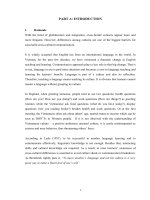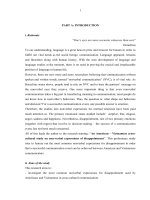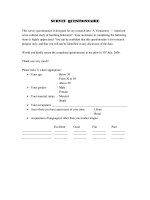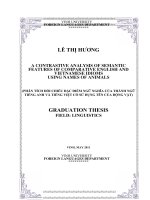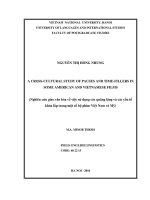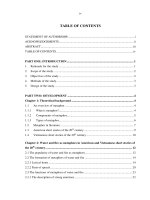An american vietnamese cross cultural study of interrupting and asking for clarification in business meetings
Bạn đang xem bản rút gọn của tài liệu. Xem và tải ngay bản đầy đủ của tài liệu tại đây (567.06 KB, 70 trang )
VIETNAM NATIONAL UNIVERSITY, HANOI
UNIVERSITY OF LANGUAGES AND INTERNATIONALSTUDIES
FACULTY OF POST-GRADUATE STUDIES
BÙI THỊ MAI
AN AMERICAN –VIETNAMESE CROSS –CULTURAL STUDY
OF INTERRUPTING AND ASKING FOR CLARIFICATION IN
BUSINESS MEETINGS
(Nghiên cứu giao văn hóa Việt-Mỹ về cách thức ngắt lời và yêu cầu
làm rõ ý trong các cuộc họp kinh doanh)
M.A. MINOR PROGRAMME THESIS
Field: English Linguistics
Code: 60220201
HANOI – 2016
VIETNAM NATIONAL UNIVERSITY, HANOI
UNIVERSITY OF LANGUAGES AND INTERNATIONALSTUDIES
FACULTY OF POST-GRADUATE STUDIES
BÙI THỊ MAI
AN AMERICAN –VIETNAMESE CROSS –CULTURAL STUDY
OF INTERRUPTING AND ASKING FOR CLARIFICATION IN
BUSINESS MEETINGS
(Nghiên cứu giao văn hóa Việt-Mỹ về cách thức ngắt lời và yêu cầu
làm rõ ý trong các cuộc họp kinh doanh)
M.A. MINOR PROGRAMME THESIS
Field: English Linguistics
Code: 60220201
Supervisor: Prof. NGUYỄN QUANG, Ph.D.
HANOI – 2016
DECLARATION
I certify that the work presented in this research report has been performed and
interpreted solely by myself. I confirm that this paper is submitted in fulfillment of the
requirement for the M.A. Degree and has not been submitted elsewhere in any other
form for the fulfillment of any other degree or qualification.
Hanoi, 2016
Bùi Thị Mai
i
ACKNOWLEDGEMENTS
This M.A thesis could not have been accomplished without the invaluable
help, encouragement and support form a number of people who I would like to show
my sincerest gratitude and appreciation.
To begin with, I would like to express my greatest and deepest thankfulness to
Prof. Nguyen Quang, my supervisor, for his enthusiastic and precious guideline and
advice throughout the duration of my thesis. Without his instruction and supervision,
this thesis could not have reached the fulfillment.
Additionally, I wish to send my special thanks to Mr. Hoang Van Nam, a sales
representative at Danko Logistic Company, for his wholehearted facilitation. Without
his support, I cannot obtain emails for contacting American and Vietnamese
businesspeople to ask for their participation in my study. Thus, my honest thanks also
come to the American and Vietnamese businesspeople who passionately provide their
responses to my DCT and MCQ.
Last but not least, I owe a great debt of gratitude to my family and
relatives particularly my father, mother and brother who have always supported
me and supplied the best conditions for me to complete this thesis.
ii
ABSTRACT
This paper is carried out at endeavor of exploring the linguistic politeness
strategies utilized by the Vietnamese and the American businesspeople in making
interruption and asking for clarification in business meetings. From that, major
similarities and differences between the two languages in this regard are revealed.
On the basis of quantitative method, discourse completion task (DCT) is
employed to collect data from participants including thirty Vietnamese native speakers
and American ones who are currently working in business sector. The result reveals
that the positive politeness strategy namely “minimizing imposition” is the most
common strategy used by American businesspeople while their Vietnamese
counterparts prefer “apologizing and minimizing imposition” in semiformal and
informal business meetings. Moreover, the speaker‟s ages, genders and positions have
great influence on the choice of politeness strategy for Vietnamese businesspeople
while those factors make no significant influence on the American ones.
iii
TABLE OF CONTENTS
Declaration ........................................................................................................................ i
Acknowledgements ..........................................................................................................ii
Abstract .......................................................................................................................... iii
Table of contents ............................................................................................................. iv
List of abbreviations.......................................................................................................vii
List of tables ................................................................................................................. viii
List of figures .................................................................................................................. ix
CHAPTER I: INTRODUCTION ................................................................................. 1
1. Rationale ...................................................................................................................... 1
2. Significance of the study .............................................................................................. 1
3. Aims and objectives of the study ................................................................................. 2
3.1. Aims of the study ................................................................................................... 2
3.2. Objectives of the study .......................................................................................... 2
4. Scope of the study ........................................................................................................ 2
5. Research questions ....................................................................................................... 3
6. Research method .......................................................................................................... 3
7. Structure of the study ................................................................................................... 3
CHAPTER II: THEORETICAL BACKGROUND .................................................. 5
1. Key concepts defined and discussed ............................................................................ 5
1.1. Culture ................................................................................................................... 5
1.2. Business culture ..................................................................................................... 5
1.2.1. Overview of American business culture ......................................................... 6
1.2.2. Overview of Vietnamese business culture ...................................................... 7
1.3. Cross- culture and cross-cultural communication ................................................. 8
2. Overview of cross-cultural pragmatics ........................................................................ 8
3. Interrupting as a speech act .......................................................................................... 9
iv
3.1. Definition of interrupting....................................................................................... 9
3.2. Theory of speech act ............................................................................................ 10
3.3. Interrupting as a speech act ................................................................................. 11
4. Politeness strategies in interrupting and asking for clarification ............................... 12
4.1. Politeness and politeness strategies ..................................................................... 12
4.1.1. Politeness ....................................................................................................... 12
4.1.2. Politeness super-strategies............................................................................. 13
4.2. Politeness strategies in interrupting and asking for clarification......................... 17
4.3. Previous studies on interrupting and asking for clarification .............................. 18
CHAPTER III: METHODOLOGY .......................................................................... 21
1. Data collection instruments ........................................................................................ 21
1.1. Multiple choice questionnaire ............................................................................. 21
1.2. Discourse completion task ................................................................................... 21
2. Participants ................................................................................................................. 22
3. Data collection procedure .......................................................................................... 23
4. Data analysis method ................................................................................................. 23
CHAPTER IV: FINDINGS AND DISCUSSION..................................................... 24
1. Comments on MCQ ................................................................................................... 24
2. How do Vietnamese and American businesspeople interrupt and ask for clarification
in business meetings? ..................................................................................................... 24
2.1. In formal meetings ............................................................................................... 24
2.2. In semi-formal meetings ...................................................................................... 26
2.2.1. Vietnamese findings ...................................................................................... 26
2.2.2. American findings ......................................................................................... 29
2.3. In informal meetings ............................................................................................ 32
2.3.1. Vietnamese findings ...................................................................................... 32
2.3.2. American findings ......................................................................................... 34
v
3. The similarities and differences ................................................................................. 37
3.1. Similarities ........................................................................................................... 37
3.2. Differences ........................................................................................................... 37
3.2.1. Differences in semi-formal meetings ............................................................ 38
3.2.2. Differences in informal meetings .................................................................. 40
CHAPTER V: CONCLUSION .................................................................................. 42
1. Summary of main findings ......................................................................................... 42
2. Limitations ................................................................................................................. 43
3. Suggestions for further study ..................................................................................... 43
REFERENCES ............................................................................................................. 44
APPENDIXES ................................................................................................................ I
vi
LIST OF ABBREVIATIONS
DCT: Discourse completion task
FTA: Face threatening act
H: Hearer
MCQ: Multiple choice questionnaire
NPS: Negative politeness strategy
PPS: Positive politeness strategy
S: Speaker
vii
LIST OF TABLES
Table III.1Vietnamese businesspeople and their American counterparts‟ responses in
formal meetings
Table III.2 Vietnamese businesspeople‟s use of politeness strategies in semiformal
meetings
Table III.3American businesspeople‟s use of politeness strategies in semiformal
meetings
Table III.4Vietnamese businesspeople‟s use of politeness strategies in informal
meetings
Table III.5American businesspeople‟s use of politeness strategies in informal meetings
Table III. 6 Vietnamese businesspeople versus their American counterparts in the use
of politeness strategies in semiformal meetings
Table III. 7 Vietnamese businesspeople versus their American counterparts in the use
of politeness strategies in informal meetings
viii
LIST OF FIGURES
Figure II.1 Possible Strategies for Doing FTAs (Brown/Levinson, 1987:60)
Figure II.2 How to get a pen from someone else (following Brown/Levinson 1987)
(Yule, 1996:66)
Figure III.1Vietnamese businesspeople‟s use of politeness strategies in semiformal
meetings
Figure III.2 American businesspeople‟s use of politeness strategies in semiformal
meetings
Figure III.3 Vietnamese businesspeople‟s use of politeness strategies in informal
meetings
Figure III.4American businesspeople‟s use of politeness strategies in informal meeting
Figure III.5Vietnamese businesspeople versus their American counterparts in the use
of politeness strategies in semi-formal meetings
Figure III.6Vietnamese businesspeople versus their American counterparts in the use
of politeness strategies in informal meetings
ix
CHAPTER I: INTRODUCTION
1. Rationale
Language has become an indispensable part in the development and civilization
of human beings. Language is not only for communication but also for cultural
exchange among nations. The close association between language and culture is
undeniable. Hence, it is very difficult for an individual to acquire a language without
studying and understanding its culture.
Cross-cultural communication is an interesting and attractive field to find out
the similarities and differences between languages and cultures in various situations in
terms of speech acts and politeness strategies. Many studies regarding the speech acts
of requesting, giving and receiving compliments, promising and soon have been carried
out in Vietnam and in other countries where learners of English are of different
language backgrounds. However, „interrupting and asking for clarification‟ in
conversations in general and in the context of business meetings in particular is one of
the areas that is not paid much attention to.
There are different ways to interrupt and ask for clarification in Vietnamese and
in American English. However, how to interrupt politely and get effectiveness of
clarifying are by no means easy. People often have difficulties selecting appropriate
and polite ways to interrupt another person in another language and in different
contexts. This leads the author to the decision to conduct research into “An American –
Vietnamese cross-cultural study of interrupting and asking for clarification in business
meetings” to find out the similarities and differences in how businesspeople interrupt
and ask for clarification in these situations in the two different languages and cultures.
2. Significance of the study
Finding out the similarities and differences in interrupting and asking for
clarification between Vietnamese and American entrepreneurs in the context of
business meetings is expected to make a significant contribution to cross-cultural
1
pragmatics in theory, and effective communication in practice. Therefore, Vietnamese
businesspeople can be more confident when communicating and attending business
meetings with American counterparts.
3. Aims and objectives of the study
3.1. Aims of the study
In the light of cross-cultural pragmatics, this study aims at comparing and
contrasting linguistic politeness strategies in the speech acts of interrupting and asking
for clarification employed by American businesspeople and their Vietnamese
counterparts in business meeting context.
3.2. Objectives of the study
The study is designed:
firstly, to investigate ways of interrupting and asking for clarification in
business meetings in Vietnamese and American English;
secondly, to compare and contrast the use of politeness strategies in the
ways the Vietnamese and American businesspeople interrupt and ask for
clarification in business meetings
4. Scope of the study
The
English-speaking informants to be surveyed
are
all
American
businesspeople and their Vietnamese-speaking counterparts are all Northern
Vietnamese.
The study only focuses on the verbal aspects of interrupting and asking for
clarification. The analysis of the data collected from the survey questionnaire
concentrates on the ways the American and Vietnamese businesspeople of different
ages, genders and positions interrupt and ask for clarification in business meetings.
This would mean major similarities and differences between the two cultures would be
drawn out from the analysis of the use of negative politeness and positive politeness
strategies.
2
5. Research questions
To fulfill the objectives above, the answers to the following research questions are
sought:
1. What
politeness
strategies
are
used
by
American
and
Vietnamese
businesspoeple in interrupting and asking for clarification in business meetings?
2. What are the major similarities and differences in interrupting and asking for
clarification in terms of politeness strategies between the Vietnamese and
American businesspeople?
6. Research method
The main method of this study is quantitative. All the considerations, remarks,
interpretations, comments and assumptions given in this study are based largely on the
analysis of statistic data with reference to publications. The practical access includes:
conducting survey questionnaires, studying relevant publications, discussing with
American and Vietnamese colleagues, and consulting with the supervisor.
Survey research is the method of gathering data from respondents supposed to
be representatives of some population. In this survey, the author samples a population.
Since populations can be quite large, the researcher directly questions only sample of
the population. Therefore, this method allows the researcher to gain potential
generalizability. Besides, survey research tends to be reliable method if questionnaires
are well-constructed and standardized, (Blackstone, 2012).That is the reason why
survey method is employed in this study.
7. Structure of the study
The thesis consists of the followings:
Chapter I: INTRODUCTION
This chapter includes the rationale, aims, objectives and scope of the study.
Chapter II: THEORETICAL BACKGROUND
3
Such key concepts as culture, cross-culture, speech acts, and politeness are defined,
and politeness principles, politeness strategies in interrupting and asking for
clarification are critically discussed. Also, a review of related studies will be presented.
Chapter III: METHODOLOGY
This chapter provides a methodological framework for collecting and analyzing data.
Chapter IV: DATA ANALYSIS AND FINDINGS
In this chapter, data analysis and findings of the study are presented with the
illustration of tables and charts.
Chapter V: CONCLUSION
Summary of the major findings and suggestions for further research are presented in
this part.
4
CHAPTER II: THEORETICAL BACKGROUND
1. Key concepts defined and discussed
1.1. Culture
There are probably as many conceptions of culture as there are researchers in
the field. Traditionally, culture has either been seen as a set of symbolic meanings
located in the minds of people or been defined as a context variable. Cultures are seen
as both products of past behavior and as shapers of future behavior and at the same
time; humans are seen as producers of culture and are being influenced by it (Segall,
Dasen, Berry, &Poortinga, 1999). Levine and Adelman (1993:17) give a more concrete
definition: “Culture is a shared background (for example national, ethnic, religious)
resulting from a common language and communication style, customs, beliefs,
attitudes and values.”
Recent approaches comprehend cultures as “dynamic open systems that spread
across geographical boundaries and evolve through time” (Hong & Chiu, 2001, p. 181)
rather than stable and static entities. In short, the author of this thesis is in line with the
idea that culture is always changing because it consists of learned patterns of behavior
and belief. Obviously, language cannot occur alone and is never separated from social
activities and its culture.
1.2. Business culture
According to McCarthy (1996: 4), business culture “embodies the character or
ethos of business as reflected in the way its personnel think and act”. Regarding this
term, Gallagher (2003) defines business culture in terms of what it both is and is not.
“A business culture is your values and beliefs, generally unspoken, your style, the type
of people you hire and what behavior you reward.” In contrast, business culture is not
“your products and services, promoted externally, your policies and procedures, your
recruiting process and what behaviors you say you want”, (p. 4). Overall, business
5
culture is built from time-tested and conventional business practices. In other words,
business practices and ways of thinking over a long period of time shape the business
culture of a country.
1.2.1. Overview of American business culture
According to Gary (1999), the U.S is a society of cultural diversity. However,
there also exists a dominant culture and immigrants became a part of this culture by
giving up their differences so that they could fit into the mainstream of the society.
As John (2008) points out, Americans belong to a rule-based culture, in other words;
behaviors are based on respects for rules and personal relationships are relatively
unimportant in enforcement of rules. This characteristic also makes the U.S a “lowcontext” culture in the sense that “Americans are direct and have no problems of
spelling out what they want”, (Katrine, 2007, p.4).
Yin‟s (2002) shows that American participants use communication as a means
to convey a positive self-image. This result could be due to the particularly high value
of the U.S. culture on individualism dimension. The U.S. participants in his study are
also concerned about making others feel good about themselves as well (i.e., equally
important and validated). These values also have influences on American business
communication.
Firstly, they tend to “get down to business” in a meeting much more quickly
than in cultures where relationships are important. Secondly, an action plan or agenda
with a clear cut schedule is provided at almost all formal business meetings, and
contracts are written out ahead of time. In negotiating, American businesspeople are
more likely to be very open and direct, and normally do not enjoy haggling.
Additionally, Americans tend not to be comfortable with silence and will make every
effort to maintain constant communication. Interruptions are not always welcomed
either; in presentations all questions and comments should be held to the end of a
gathering unless otherwise specified (Gesteland, 1999).Unlike many other countries,
6
business in the United States is based on personal power rather than class, status or
seniority. Hiring relatives or friends solely based on favoritism is completely unethical
in the United States. Furthermore, in less formal business settings, Americans are more
relaxed and place great emphasis on personal achievements. Americans are not
reserved about their personal opinions and express themselves freely in the work
environment, including giving input on important decisions, (Gary, 1999).
1.2.2. Overview of Vietnamese business culture
Katrine (2007) reckons that Vietnam, like other Asian countries, has a „high
context‟ culture in the sense that words spoken may vary in their meaning depending
on the context, and people maintain close relationships over a long period of time.
Similarly, it can be said that Vietnam belongs to relationship-based culture, according
to John (2008). More specifically, in relationship-based cultures, behaviors are
regulated through close supervision by authority figures; improper behaviors may lead
to shame, loss of face, punishment or ostracism, (John, 2008). Moreover, Adler and
Gundersen (2008) when describing individualism versus collectivism claims that
Vietnamese culture is the later case where employees see themselves as part of a group
whose needs should determine behavior. Besides, Confucian concept and hierarchy
also have significant influence in Vietnam. Hence, these values greatly determine the
way Vietnamese people conduct their business.
Firstly, hierarchy and face manifest themselves in different ways at business
meetings. For example, the most senior person should always enter the room first.
Silence is also common in meetings where someone disagrees with another and
remains quiet, so as not to cause a loss of face. Secondly, relationships are critical to
successful business partnerships. Meetings in Vietnam are generally relaxed affairs, but
small talk is also used to establish a sense of familiarity and of a relative status among
the participants. As Vietnam is a very hierarchical society, Vietnamese in general feel
uncomfortable if they do not know the status of the people with whom they interact,
7
(Chambers, 1997).In addition, in Vietnam where high power-distance is associated
with low uncertainty avoidance, employees view their organizations as families, and
bosses are expected to take care of their employees financially and physically, (Adler
& Gundersen, 2008).
1.3. Cross- culture and cross-cultural communication
Cross-culture can be understood as “the meeting of two cultures or languages
across the political boundaries of nation-states” (Kram, 1998: 81). The term “crossculture” or “interculture” usually refers to the meeting of two cultures. They are
predicated on the equivalence of one nation-one culture-one language and on the
expectation that a “culture-shock” may take place upon crossing national boundaries.
Cross-culture seeks ways to understand the other on the other side of the border.
As for the concept of cross-cultural communication, researchers are of different
opinions from divergent angles. Jia (1997) defines cross-cultural communication as a
subject which focuses on the communicative activities of people from different cultural
background and the essence and rules of the communicative activities. The consensus
viewpoint is that the term “cross-cultural” does not only mean the communication of
different countries, but also the communication of people from different nations,
different social status and so on.
Thus,
cross-cultural communication
is
the
exchange and negotiation of information ideas, feelings and attitudes between
individuals who come from different cultural backgrounds.
2. Overview of cross-cultural pragmatics
Kasper and Blum-Kulka (1993) define cross cultural pragmatics as “the study of
linguistic acts by language users from different cultural backgrounds,” (as cited in
Locastro, 2012:80).According to Wierzbicka (1991), the term “cross-cultural
pragmatics” has been used in the study of language that focuses on several
communicative aspects including the way people speak differently in different
communities; and how different speech styles reflect different cultural values and
8
priorities. These ideas are adopted in the most recent study on “politeness strategies as
linguistic variables” (Holmes 2009), which acknowledges that different cultures have
different methods of expressing consideration for others.
Wierzbicka (1991) suggests that the term “cross-cultural” is used for describing
not only native-non-native interactions, but also any communicative patterns
employed between two people who, in any particular domain, do not share a
common linguistic or cultural background. Cross-cultural pragmatics isn‟t important
only for comparing different cultures but also for general pragmatics as a whole.
General pragmatics is only able to phrase its theories with the help of cross-cultural
studies.
3. Interrupting as a speech act
3.1.Definition of interrupting
Although the term “interrupting” has drawn much attention from researchers,
there is still little consensus about the definition of interrupting. According to West and
Zimmerman (1975), interrupting can be seen as a form of simultaneous speech, which
is defined as a violation of a speaker‟s turn at talk and as a device of exercising power
and control in conversation. Moreover, James and Clarke (1988) indicate that
interrupting happens when one person initiates talks while another person is already
talking.
Regarding the classification of interruption, various categorization schemes for
interruption are proposed by different researchers. In this study, the author would adopt
the classification of interruption proposed by Roger and Schumacher (1983) in which
interruptions are divided into successful and unsuccessful interruptions
Since the aims of this paper is to focus on politeness strategies employed in the way
businesspeople interrupt and ask for clarification, only successful interruption is
considered in this research. According to Roger and Schumacher (1983), successful
9
interruptions consist of those events in which the first speaker is prevented from
completing an utterance by the second speaker taking the floor.
Interrupting actions may have different intentions such as showing
disagreement, asking for opinion, adding ideas or asking for clarification. The case in
this study is interruption to ask for clarification. This situation usually originates from
the listeners‟ divergent problems but mostly resulting from the circumstance when the
listeners do not understand what the speaker is saying.
3.2. Theory of speech act
One of the important approaches within interlanguage pragmatics is the
application of the notion of speech acts. According to Yule (1996:47), “Actions
performed via utterances are generally called speech acts.”
Austin (1962, pp. 94-108) categorizes the utterance into three layers:
(1) The locutionary act refers to an utterance simply constructed by its literal or
propositional meaning.
(2) The illocutionary act is the real action performed by the utterance, i.e. the
conventionalized meaning.
(3) The perlocutionary act refers to the effect of the utterance upon the listener.
Austin considered the illocutionary act as the most important of the three acts because
it is actually what the speaker wants to achieve through the action of uttering the
sentences. Searle (1976) asserts that all illocutionary acts fit into five categories:
(1)Representatives which tell people how things are, (e.g. suggest, deny, swear, report,
etc.)
(2) Directives are attempts by the speaker to get the hearer to do something (e.g. order,
request, invite, command, etc.)
(3)Comissives by which the speaker commits himself to do things (e.g. intend, promise,
vow, undertake, etc.)
10
(4)Expressive express speakers‟ feelings and attitudes (e.g. thank, congratulate,
apologize, detest, etc.)
(5)Declarations or declaratives bring about changes in the institutional state of affairs
through utterances (e.g. resign, appoint somebody, fire somebody, etc.). For instance, a
priest stating: “I now pronounce you man and wife”.
Speech acts may be either direct or indirect depending on the direct and indirect
relationships between their structures and functions.
3.3. Interrupting as a speech act
In English, as Yule (1996) states, more specific labels are normally given to
speech acts, namely apology, complaint, compliment, invitation, promise, or request.
The basic function of interruption is to prevent the first speaker from being able to
finish what he/she is saying and to allow the second speaker to take over the floor
(James & Clarke, 1993). It is often regarded negatively as violating normal
conversation rules, rude and disrespectful act. However, James & Clarke (1993)
indicate that interruption can be supportive and cooperative speech act as the speakers
can work out a topic together and produce shared meaning. Hence, interruption can
sometimes be neutral in case one might interrupt because of a problem with the
communicative process; that is, one‟s failure in understanding what the speaker is
saying. Under such circumstance, one may legitimately break into asking for
clarification.
Based on the theory proposed by Yule (1996) and Searl (1976),
interrupting and asking for clarification belongs to the speech act of request. It is the
kind of request for verbal action, that is, the speaker is asked to clarify what he or she
is saying; for example: Could you explain what you mean by….?
11
4. Politeness strategies in interrupting and asking for clarification
4.1. Politeness and politeness strategies
4.1.1. Politeness
Beside theory of speech acts, particularly requests, the theory of politeness can
be considered one of the most fundamental backgrounds of this paper. As a result, the
following part of this thesis mentions the theoretical background related to politeness
and politeness theory. Since politeness and politeness strategies tend to be one of the
chief aspects of pragmatics, abundant research has been conducted in this area by
divergent researchers. However, earlier studies seem to all stem from the theory
suggested by Brown &Levison (1987). Consequently, in this thesis, the theory of
Brown &Levinson (1987) serves as the principal foundation.
To begin with, Yule (1996:60) defines politeness as “the means employed to
show awareness of another person‟s face.” Accordingly, it is essential to trace Brown
and Levinson‟s definition of „face‟. This term is considered as:
The public self-image that every member wants to claim for himself, consisting in two
related aspects:
a) Negative face: the basic claim to territories, personal preserves, rights to nondistraction- i.e. to freedom of action and freedom from imposition
b) Positive face: the positive consistent self-image or „personality‟ (crucially
including the desire that this self-image be appreciated and approved of) (Brown
and Levinson 1987:61)
Although there is a mutual awareness for both people (speaker and hearer) in a
conversation to preserve each other‟s face, some circumstances when speaker
(henceforth S) says something that threatens another individual‟s expectations of selfimage (their “face”) are discussed by Yule (1996). In this case, this is described as a
face threatening act (henceforth FTA). In their theory, Brown &Levinson (1987:65)
also admit that:
12
An FTA is any verbal act a speaker (S) addresses to any hearer (H) with a
specific intention which S intends H to recognize, this recognition being the
communicative point of S‟s doing the communicative act. Any utterance is
always to some extent an imposition on H and S; any utterance is intrinsically
face-threatening. Some FTAs are more threatening than others.
Yule (1996)tends to have an agreement in defining the concept of politeness with
Brown &Levinson (1987) as he declares that politeness can be treated as a fixed
concept. However, Watts (2003:16) states that “politeness is a dynamic concept,
always open to adaptation and change in any group, in any age and indeed any time”.
In this regard, Watts appears to refute the universality of politeness as proposed by
Brown and Levinson (1987), but considering it a flexible conception.
In short, in person, various definitions of politeness, the writer tends to fall on Yule
(1996)‟s viewpoint.
4.1.2. Politeness super-strategies
Concerning the standpoint of “face” and face wants, the hypotheses of
politeness strategies have been varied; nevertheless, in this paper, the author would like
to present Brown and Levinson theory since it is one of the most prevalent theories and
adopted for this research. These five strategies (which are referred to as the five superstrategies in Brown &Levinson, 1987) are illustrated in the below figure:
Figure II.1. Possible Strategies for Doing FTAs (Brown/Levinson, 1987:60)
13
Aiming at clarifying these strategies, Yule (1996) applies this theory into a specific
situation: “How to get a pen from someone else” as presented in the following chart:
How to get a pen from
someone else
Say nothing
Say something
(but search in bag)
Off record
On record
(´I forgot my pen´)
Bald on record
Face saving act
(´Give me a pen)
Positive politeness
Negative politeness
(´How about letting me use your pen?´)
(´Could you lend me a pen?´)
Figure II.2. How to get a pen from someone else (following Brown/Levinson 1987)
(Yule, 1996:66)
The conception of Brown &Levinson about the typical characteristics as well as the
chief distinctions of each mentioned politeness strategy as below:
Bald on-record does nothing to minimize threats to H‟s “face” and avoid
FTAs.
Positive politeness strategy shows S recognizes that H has a desire to be
respected. It also confirms that the relationships is friendly and expresses
group reciprocity.
Negative politeness also recognizes H‟s face. But it also recognizes that S is
in some way imposing on that face.
14
